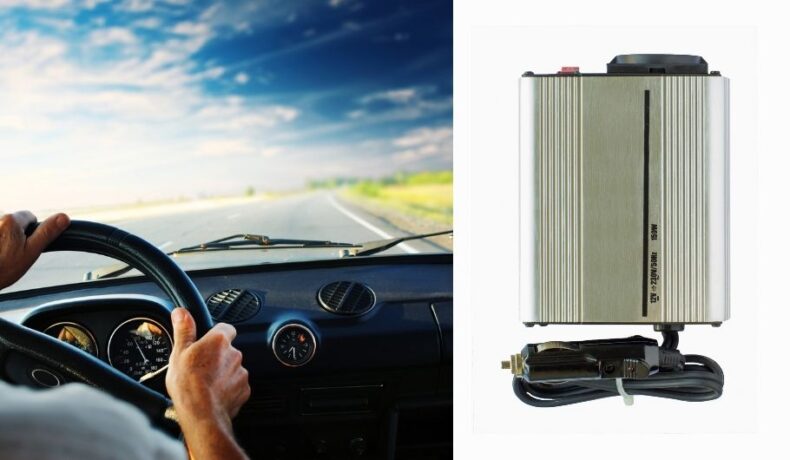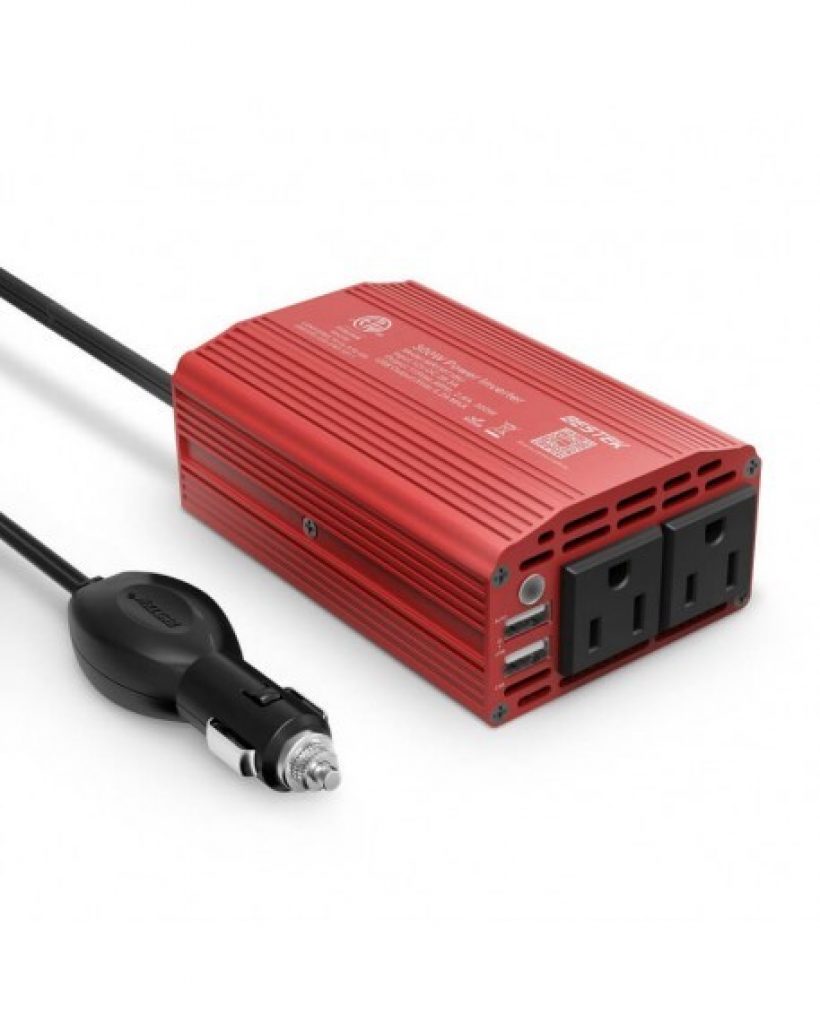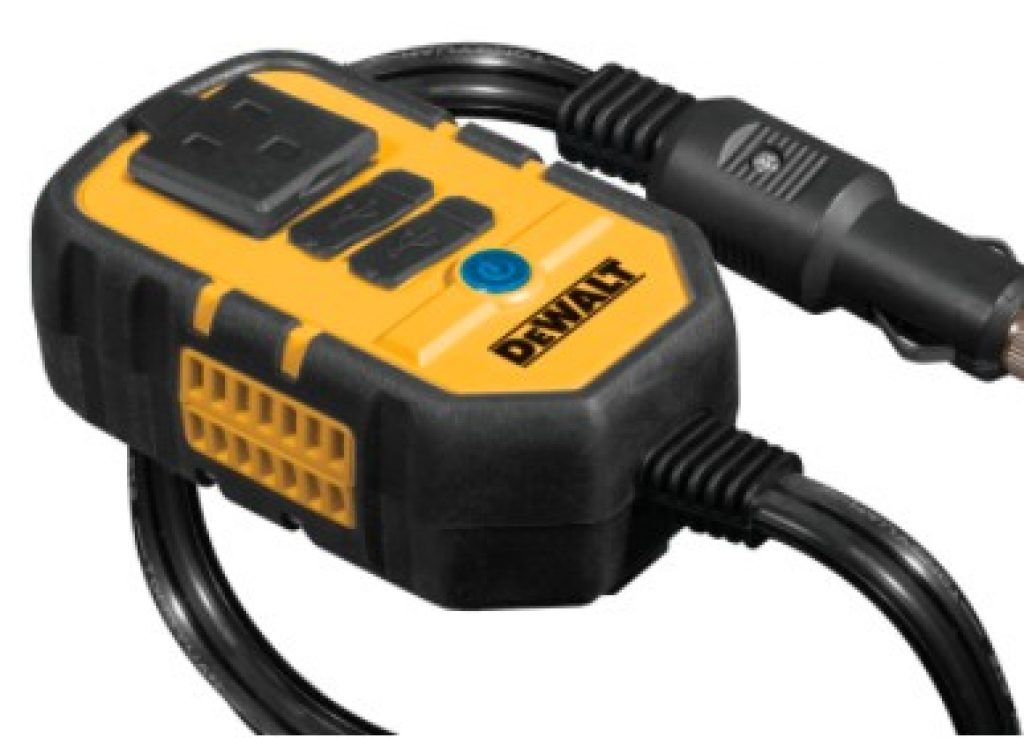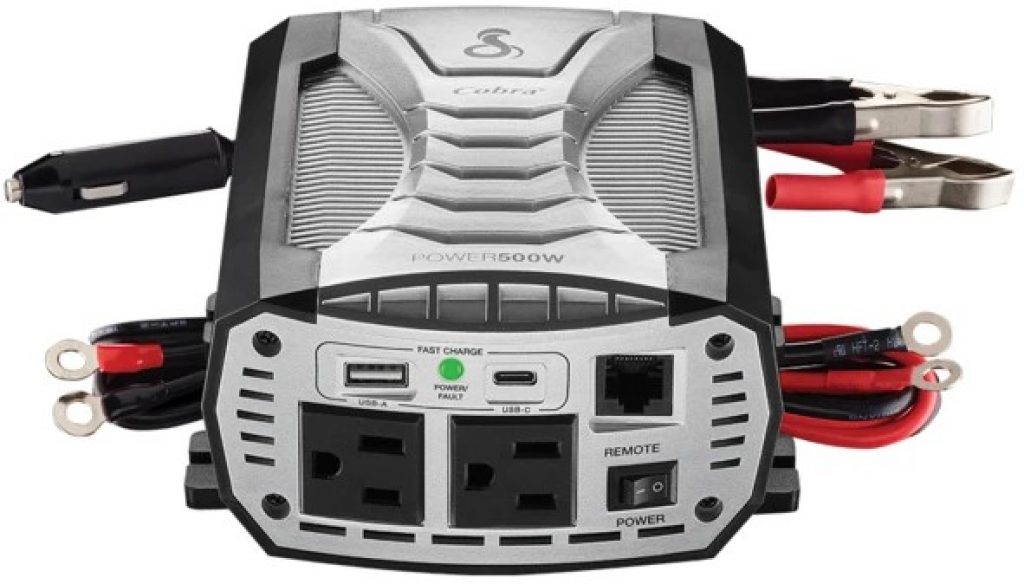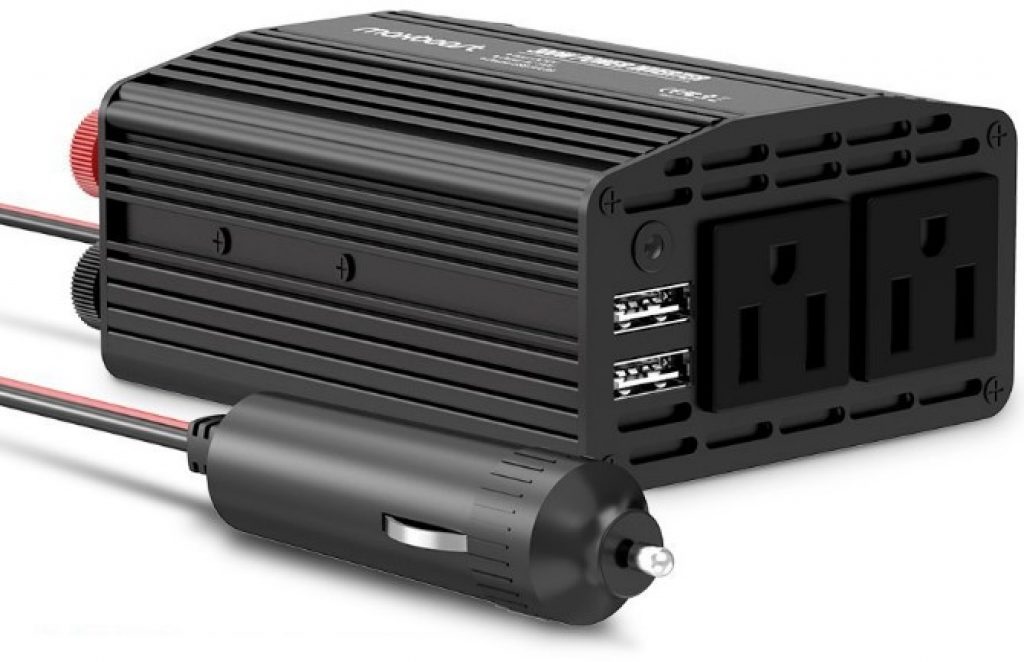Whether you’re going on road trips or simply working from place to place, you should have a reliable power source to charge your electronics on the go.
Some cars have built-in USB ports or are compatible with 12V phone chargers. Unfortunately, this is not enough to charge laptops or electronics requiring 120V AC outlets.
Ideally, you want to use a specially designed power inverter for cars. This device converts the 12V DC power output of your car battery into a 120V AC output that powers most low-consumption electronics.
This article will cover the basics of a car power inverter, its benefits, and its implications for your battery. Additionally, we’ll review some of the best options available.
Table of Contents
Power Inverter For Your Car (Everything You Need To Know)
While the circuit for the car power inverter is quite complex, understanding how it works is relatively simple. This device converts the 12V DC output of a battery into a 120V AC output, by going through two stages.
The first stage increases the DC voltage from 12V up to 10 times that voltage. To achieve this, the power inverter for the car includes a DC to DC converter, increasing the voltage from 12V DC up to 145 volts DC. This high voltage considers voltage losses due to the operation of the circuit.
The second stage creates a Modified Sine Wave (MSW) or Pure Sine Wave (PSW) by using the DC high voltage output. For this stage, the inverter includes advanced MOSFETs that generate this sine wave by using the DC signal, creating the AC output.
A 110-120V MSW or PSW is perfect to power appliances and electronics. At the AC output of the inverter, you can finally plug and power your electronics.
5 Best Power Inverters For Your Car
Bestek 300W Power inverter
The 300W Bestek power inverter for cars is light and compact. This inverter can deliver around 25 amps, which is equivalent to a 300W rated power output, but you can get a max power output of 360W.
This inverter features 2 x 120V AC outlets and 2 x 5V/2.4A USB ports, ideal to power AC appliances, charge laptops, and smartphones with fast charging. The inverter includes a built-in low-battery alarm and shutdown system that protects your car battery.
Additionally, the inverter can be plugged through the automobile auxiliary power outlet for 150W loads or with battery clips for higher loads. This inverter includes an operational LED indicator that turns green when operating or red when shut down.
DeWalt 140W Power Inverter
The DeWalt 140W power inverter for cars is a reliable and robust option. This inverter connects via the automobile auxiliary power output, delivering a continuous 100W output, but it can deliver 120W for 60 minutes or 140W for 20 minutes.
The DeWalt power inverter features a 1 x 120V AC outlet with a modified sine wave, which can power most low-demand electronics requiring 100 – 140W. This power inverter for cars also features a 1 x 5V/3.1A USB port, ideal for charging smartphones via fast charging.
To make it more durable and robust, DeWalt covered the inverter with a rubber casing, making it impact-resistant. This device includes an on/off button, allowing you to leave it plugged into the auxiliary port without consuming power when off.
Cobra 500W Power Inverter
Cobra is a quality manufacturer designing all types of electronics, including high-end power inverters for cars. It is a quality option that you can use occasionally or install in your vehicle for regular use.
With the 500W Cobra power inverter, you can continuously power a 500W load or supply a 1,000W peak demand. This inverter includes 2 x Ground-Fault Circuit Interrupters (GFCI) 120V modified sine wave outlets, 1 x 5V/3.0A USB A port, and 1 x 9V/1.67A USB C port.
You can plug this inverter via an automobile auxiliary power outlet or with battery clips. This inverter includes a protection system against overload, over-temperature, reversed polarity, short circuit, and under/overvoltage.
Maxboost 300W Power Inverter
The Maxboost 300W power inverter is another great option. It has a high-quality manufacturing process, robust casing, and an aesthetic design. This inverter can power most electronics and charge smartphones.
It features a 2 x 110V AC outlet, which delivers a continuous power output of 300W or instantaneous power output of 700W. Additionally, it includes 2 x 5V USB ports, featuring a fast-charging system with a max current of 2.4A.
You can plug this inverter via an automobile auxiliary power outlet or with battery clips. This equipment includes protection against under/over-voltage, overheating, short-circuit, overcharging, and overload.
Foval 150W Power Inverter
If you’re looking for a light, compact, and easy-to-carry power inverter, the Foval 150W is ideal for you. This inverter features a 1 x 110V AC outlet, which can deliver a continuous power output of 150W, 1 x 5V/1A USB port for regular charging, and 1 x 5V/2.1A USB port for fast-charging.
The Foval power inverter has to be plugged into automobile auxiliary power outlets. This model includes protection against overheating, under/over-voltage, short-circuit, overload, and overcharging. A Foval inverter is an excellent option to power low-consumption electronics, like laptops, portable DVDs, charging smartphones, and many other applications.
Benefits of Having a Power Inverter in Your Car?
A power inverter for a car is a reliable device that provides you with a 120V AC power source on the go. Some of the benefits include:
- Charging laptops and electronics from anywhere.
- Using the car battery as an emergency power source during blackouts or emergencies.
- Powering DVDs, high audio equipment, and other entertainment devices for your car.
- Providing a reliable power source when hiking or camping.
Do Power Inverters Damage Your Car?
Under ideal conditions, a car battery lasts around 3 – 5 years. This lifespan varies for different climates, frequency of energy bursts, and several other factors. However, you’ll need to take some precautions when using a power inverter for your car. This will help you to avoid damaging your car battery.
Only Use the Inverter When the Engine Is Running
A power inverter demands a high load from your car battery. If the engine is running, the alternator will continuously charge the battery, allowing you to provide a load without discharging the battery. Otherwise, you will end up with a drained battery and no power to turn your car on.
Avoid Powering High Demand Electronics
It may be tempting to use the inverter as a regular 120V AC outlet in your home. But remember your car battery powers this outlet. If an electronic load demands a high amount of power and the battery discharges faster than the speed at which the car alternator can charge the battery, you may end up with a drained or even dead battery.
Understand the Power Limits of the Cigarette Lighter Socket
Some power inverters for cars go as high as 150 – 180W, but there is a reason for this. Most power inverters operate by connecting through the automobile auxiliary power outlet, known as the cigarette lighter socket.
15 amp sockets at 12V can safely run 1.5 amps @ 120V AC (150 – 180W), while 20 amps sockets at 12V can run 2 amps @ 120V AC (200 – 240W). To be on the safe side, you should only use 150 – 180W power inverters through this outlet, unless you are certain you have 20 amp sockets.
To find out, you will need to check the fuse box of your car or the manual specs of the car.
Do Power Inverters Drain Your Car Battery?
Car batteries are meant to be regularly discharged by 2 – 5%. This means that they should be taken to a 98 – 95% recommended DOD. In general, you can safely discharge a car battery up to 15% DOD. However, if you discharge it to 20 – 50% of its capacity, you will be endangering your battery.
Draining a car battery by using a power inverter with the engine turned off, is a big no-no. When you turn on the engine of your vehicle, you demand high bursts of energy from your battery. As the engine starts, the alternator kicks in, charging the battery back up again. This means, that using a properly sized power inverter with reasonable loads should not drain your battery as the inverter should be able to charge it as it is discharged.
The alternator of your vehicle can charge a fairly drained battery in around 30 minutes to 1 hour while driving. After waiting for this charging time, you can safely use the inverter for low – medium loads.
If you’re going to demand higher loads, we recommend you do so for a short period of around 30 – 60 minutes.
How Long Will A Car Battery Run A 300-Watt Inverter?
The size of your car’s power inverter doesn’t determine the duration of the battery. Instead, it is determined by the size of the load and RPM of your vehicle. A regular car battery operates at 12V and its capacity usually ranges from 50 – 75 amp-hour or 600 – 900 watt-hour.
A car alternator running even at low speeds can supply a 10 – 35 amp load @ 12V for as long as the engine is running. If the voltage of the alternator drops too much (meaning the inverter is not being able to sustain the current demand), the battery will start to supply the power. We do not recommend this as you could drain the battery.
A 10 – 35 amp @ 12V load means that you can power a 120 – 420W load if the alternator has enough speed.
Since this is hard to determine accurately, we recommend the following:
- Only power small loads of 120 – 150W at low speeds.
- Only connect higher loads when increasing the RPMs (somewhere above 1500 rpm) and you are driving at a faster speed.
- Check your alternator’s specs to verify how much current it can provide.
There is no time limit for how long your car will supply a 300W load. If you turn the engine off, a regular car battery might only power this load for around 2 – 3 hours. But doing this will drain your battery and significantly reduce its lifespan.
We recommend that you only power loads with your power inverter when the engine is running.
What’s The Biggest Inverter My Car Can Handle?
In theory, your car can supply 35 amps @ 12V loads with the alternator running even at low RPMs. This load is equivalent to demanding 420W per hour when you turn the engine on.
You can determine the size of your car’s power inverter by how it connects to the car battery.
If you plug the inverter into your vehicle via the cigarette lighter socket, you should only require 180 – 240W (depending on the fuse). To provide higher loads up to 500W, you’ll need to create a direct connection to the battery of the car by using battery clips.
Demanding too much of a load can put a strain on your battery. As such, we recommend using a 300W power inverter for regular vehicles.
For 500W power inverter installations, we recommend using vehicles with bigger alternators, dual-purpose batteries, proper wiring, and fuses sized for the application.
In these cases, there is likely space to get a separate deep cycle battery to power the inverter. This would be worth considering if the loads are intended to be run when the engine is turned off.
Final Thoughts
If you want to have a 120V AC outlet that will power most small-medium consumption appliances and some high-power electronics, power inverters are the way to go.
When using the power inverter for your vehicle, consider the size of the inverter relative to the load that your alternator can supply.
Additionally, never put too much of a load on your car battery. This will happen if you connect a high load with an alternator that cannot cover it.
Lastly, remember to follow the guidelines written in this article. That way you’ll use your power inverter correctly, keeping your battery safe while powering your electronics.

